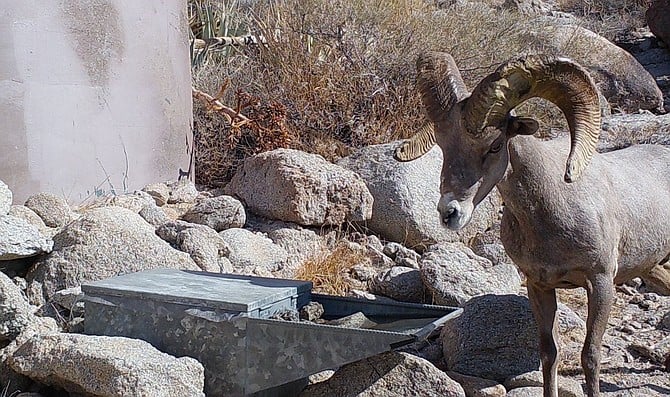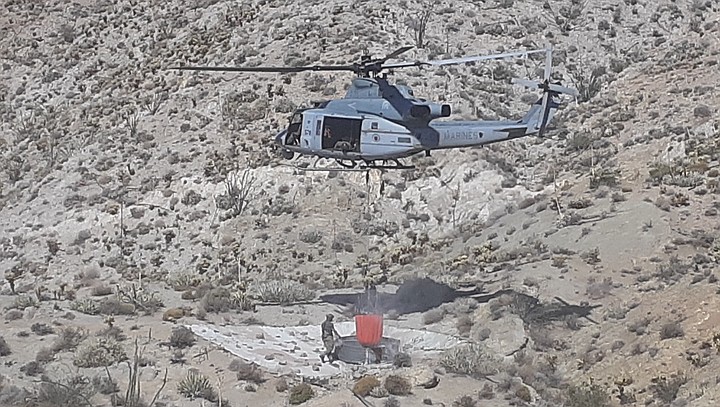 Facebook
Facebook
 X
X
 Instagram
Instagram
 TikTok
TikTok
 Youtube
Youtube

For California Department of Fish and Wildlife biologist Janene Colby, the day of the bighorn sheep emergency water drop started at 1 am. In the wee hours of Saturday, August 28, Colby and two Anza Borrego Desert State Park employees set out in a pickup truck from base camp at Fish Creek Wash. After an hour’s drive to the end of a rugged dirt road, they could go no further by truck. They got out and started hiking up to their destination: Whale Peak artificial wildlife water system — aka “guzzler”—one of hundreds of tanks in the Southern California wilderness that collect rainwater for desert-dwelling fauna. Due to maintenance issues and this year’s extreme drought, the Whale Peak guzzler was out of water. The endangered sheep that depend on it were in danger of death due to dehydration. Colby and her crew were meeting a Marine Corps helicopter bringing a refill.

Months ago, when she discovered that several of the Anza Borrego guzzlers were dry, Colby, who has worked with bighorn sheep for 17 years, had to figure out what to do next. Government agencies are obligated by the recovery plan for bighorn sheep in the Peninsular Ranges to take action to protect the sheep, which live only in Southern California and number under 1000. About 200 live in Anza Borrego. They’re cautious animals that won’t frequent water holes away from the rugged terrain in which they find safety. In some places, like Whale Peak, guzzlers are the only viable water source.
But, by design, they’re in hard-to-reach places where the sheep (and other species who rely on them) won’t be bothered by humans. Delivering water to the guzzlers is a complicated and costly undertaking — and, since they’re supposed to fill with rainwater collected by a passive process, not part of regular park maintenance. The Whale Peak water drop operation was only possible with the collaboration of several non-governmental organizations—and a volunteer from Backcountry Hunters and Anglers with a connection to the Marines.
“The Marines at Camp Pendleton were ready and willing to help us get water into the guzzlers. However, they only had one day and one helicopter so we made the decision to haul water to Whale Peak Guzzler,” said Colby.
At 4:30 on the afternoon of Friday, August 27, the UH-1Y helicopter and its crew arrived at base camp to meet the team setting up temporary water tanks, about ten flight miles from the guzzler. California senior wildlife biologist supervisor Jeff Villepique, who has overseen similar operations in the Mojave and San Bernardino and Riverside counties, advised volunteers from Desert Wildlife Unlimited and Society for the Conservation of Bighorn Sheep, along with Anza Borrego employees. Trucks carrying water donated by the California Wild Sheep Foundation and the nearby U.S. Gypsum Mine filled the dip tanks.
The crew camped overnight. On Saturday everyone had to be up and ready long before dawn brought 100-degree temperatures, and drafts from mountain heat made flying the helicopter difficult. By 5:30 am preparations were underway for the first flight, and by 7 the helicopter had put an empty receiving tank in place near the guzzler. Then the helicopter returned to base camp, where the crew attached the expandable “bambi” bucket and dipped it into the full tanks. By 7:30 the first of the water was in the receiving tank, draining onto the rain mat that collects water for the guzzler. From there water drains into pipes that feed the guzzler tanks. After four hours, two helicopter fuel runs to El Centro, and seven drops, 1400 gallons of water had been delivered to Whale Peak guzzler. By noon the helicopter headed back to Camp Pendleton.
Though it’s known that bighorn sheep might be displaced by low-flying helicopters, Villepique has been on water drops where he’s seen them come back to refilled guzzlers within an hour.
“Sometimes they’ll actually watch,” said Villepique. “We’ll see them hanging around, at a safe distance, waiting for us to leave.”
“When the sun came up, I did see a few ewes on the slopes about ¼ mile distance from the guzzler. The sheep were working their way across the upper slopes while foraging. No doubt when the helicopter arrived the sheep moved out of the area for the day. However, they likely returned the next day to find water in the guzzler,” Colby said. Next month, the team will be able to check a remote camera on the guzzler to see how many sheep came to take a drink. The supply will probably last for about two months. Hopefully more rain will arrive this winter.


For California Department of Fish and Wildlife biologist Janene Colby, the day of the bighorn sheep emergency water drop started at 1 am. In the wee hours of Saturday, August 28, Colby and two Anza Borrego Desert State Park employees set out in a pickup truck from base camp at Fish Creek Wash. After an hour’s drive to the end of a rugged dirt road, they could go no further by truck. They got out and started hiking up to their destination: Whale Peak artificial wildlife water system — aka “guzzler”—one of hundreds of tanks in the Southern California wilderness that collect rainwater for desert-dwelling fauna. Due to maintenance issues and this year’s extreme drought, the Whale Peak guzzler was out of water. The endangered sheep that depend on it were in danger of death due to dehydration. Colby and her crew were meeting a Marine Corps helicopter bringing a refill.

Months ago, when she discovered that several of the Anza Borrego guzzlers were dry, Colby, who has worked with bighorn sheep for 17 years, had to figure out what to do next. Government agencies are obligated by the recovery plan for bighorn sheep in the Peninsular Ranges to take action to protect the sheep, which live only in Southern California and number under 1000. About 200 live in Anza Borrego. They’re cautious animals that won’t frequent water holes away from the rugged terrain in which they find safety. In some places, like Whale Peak, guzzlers are the only viable water source.
But, by design, they’re in hard-to-reach places where the sheep (and other species who rely on them) won’t be bothered by humans. Delivering water to the guzzlers is a complicated and costly undertaking — and, since they’re supposed to fill with rainwater collected by a passive process, not part of regular park maintenance. The Whale Peak water drop operation was only possible with the collaboration of several non-governmental organizations—and a volunteer from Backcountry Hunters and Anglers with a connection to the Marines.
“The Marines at Camp Pendleton were ready and willing to help us get water into the guzzlers. However, they only had one day and one helicopter so we made the decision to haul water to Whale Peak Guzzler,” said Colby.
At 4:30 on the afternoon of Friday, August 27, the UH-1Y helicopter and its crew arrived at base camp to meet the team setting up temporary water tanks, about ten flight miles from the guzzler. California senior wildlife biologist supervisor Jeff Villepique, who has overseen similar operations in the Mojave and San Bernardino and Riverside counties, advised volunteers from Desert Wildlife Unlimited and Society for the Conservation of Bighorn Sheep, along with Anza Borrego employees. Trucks carrying water donated by the California Wild Sheep Foundation and the nearby U.S. Gypsum Mine filled the dip tanks.
The crew camped overnight. On Saturday everyone had to be up and ready long before dawn brought 100-degree temperatures, and drafts from mountain heat made flying the helicopter difficult. By 5:30 am preparations were underway for the first flight, and by 7 the helicopter had put an empty receiving tank in place near the guzzler. Then the helicopter returned to base camp, where the crew attached the expandable “bambi” bucket and dipped it into the full tanks. By 7:30 the first of the water was in the receiving tank, draining onto the rain mat that collects water for the guzzler. From there water drains into pipes that feed the guzzler tanks. After four hours, two helicopter fuel runs to El Centro, and seven drops, 1400 gallons of water had been delivered to Whale Peak guzzler. By noon the helicopter headed back to Camp Pendleton.
Though it’s known that bighorn sheep might be displaced by low-flying helicopters, Villepique has been on water drops where he’s seen them come back to refilled guzzlers within an hour.
“Sometimes they’ll actually watch,” said Villepique. “We’ll see them hanging around, at a safe distance, waiting for us to leave.”
“When the sun came up, I did see a few ewes on the slopes about ¼ mile distance from the guzzler. The sheep were working their way across the upper slopes while foraging. No doubt when the helicopter arrived the sheep moved out of the area for the day. However, they likely returned the next day to find water in the guzzler,” Colby said. Next month, the team will be able to check a remote camera on the guzzler to see how many sheep came to take a drink. The supply will probably last for about two months. Hopefully more rain will arrive this winter.
Comments